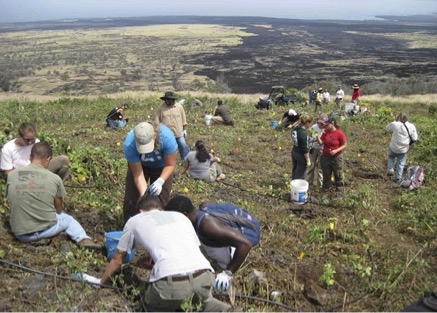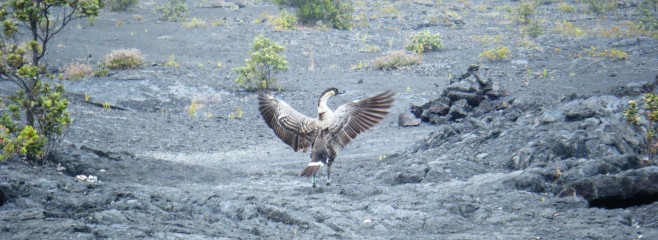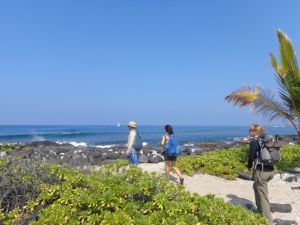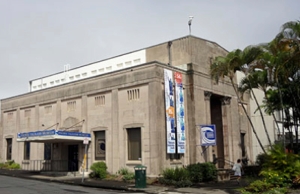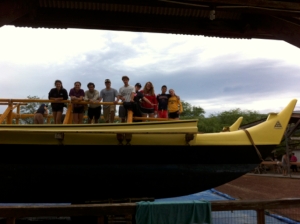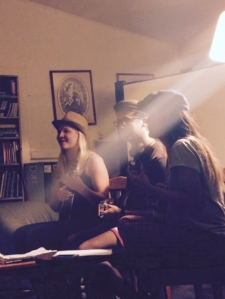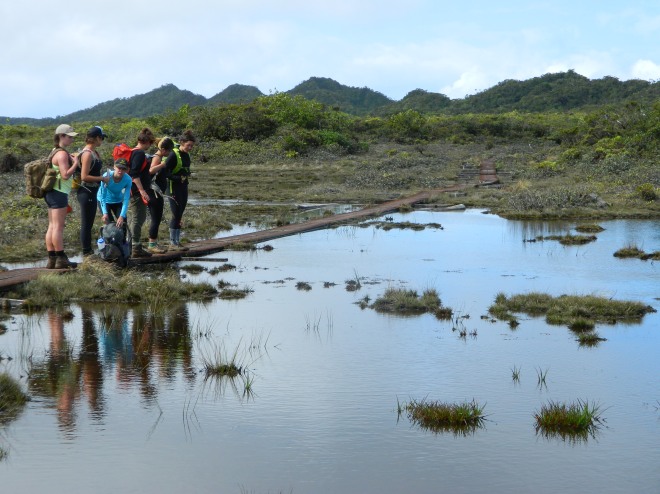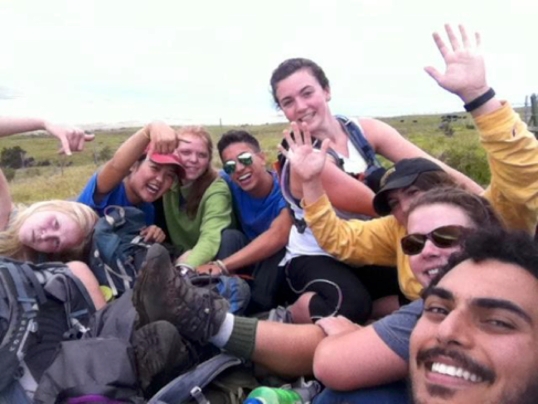Monday – we touch down in Kahului and someone remarks that the view from the baggage claim is the same at every island airport we go to. But the horizon looks distinctly different from the lava fields of Kona and the dinosaur spine ridges that greeted us in Kaua’i: the flanks of West Maui, covered in green rivulets, come down from the clouds and flow all the way to the ocean.
We wait on the curb for the rental cars, looking more forlorn than usual, and I feel like I experience the trade winds for the first time. This is shortlived, because soon, we’re piled into vans – are the Nissans smaller than the Dodge caravans? I can’t tell – and on our way to the Maui Seaside. The locally owned motel has a huge Hala (Screwpine, Pandanus tectorius) out front, white walls, and green trim. It wouldn’t have felt out of place to roll up in a Cadillac in a 70s Technicolor film.
We’re happy to eat lunch, grocery shop for the week, and make Ellie subtly ask all our Secret Valentines what kind of chocolate they like. After several power outages and more than one over budget Hui, we make our way back to the Seaside for break time. (Woo!) Some of us head to the mall; others take naps or equally long hot showers. Mazen heads over to the ocean and sees an octopus; Eric (or Ellie? unclear) kicks Christina in the head in the pool.
At 5:30, we re-group, and Kumu briefs us on our upcoming trip to Haleakala. We learn that Haleakala Crater is more of an erosional feature than a caldera, unlike Kilauea. We’re given maps and instructions to not get lost like those other kids who made it all the way to the ocean—and if we do, to call Lou to pick us up.
We’re set free to find dinner in Kahului, and many of us go to Whole Foods. After dinner, Virginia and Ellie buy matching pants, Abby, Christina, and Phoebe all find the bathing suits of their dreams. Then it’s back to the Seaside, to work late into the night on our Kaua’i Sand Dunes project! Overall, it was a solid day for the `Ohana.
Day 2 – Rain???
We wake up for breakfast at 7:30 and find a sparse packing list. In addition to two regular items, “Raincoat?” is listed at the very bottom. Some of us obeyed, others chose to rebel—after all, we’ve been having the best luck with weather, ever, right? It can’t rain on Maui, right?
Wrong. We make our way up to Kupa’a Farms on the Haleakala side of the island, only using our windshield wipers sparingly. When we arrive, the sky decides it’s time to open up. Those rebels without raincoats rue the day. Only Eric, who brought both a raincoat and rain pants, stays dry today. For the rest of us, sneakers are soaked within the hour.
This doesn’t dampen our spirits, though, and we follow Gerry Ross around his beautiful organic farm. A veteran of the Canadian Geological Survey, he and his wife moved to Maui in the 90s to start Kupa’a Farm on a 14 acre piece of land owned by his in-laws. The vegetables are so sprightly and healthy looking, the branches of the coffee trees sag with “cherries” to be picked, and the compost pile is a steamy 130 degrees Fahrenheit. We learn a lot about cover crops, food waste, natural fertilizer, and some of the insects that are a threat to some of these handsome fruits and veggies—like the Coffee Berry Borer and the Potato Nematodes. We get to see just how much effort goes into running an operation like this, and many of us are in awe of and inspired by Gerry and his family—especially since they started this farm with little to no prior experience, and learned everything they know (which is a lot) through observation and mistakes.
After our tour, we enjoy lunch in the garage and sample some of Kupa’a’s award winning coffee—it really is excellent. Then, we spend the afternoon picking coffee cherries. Gerry, who can pick 25lbs of coffee per hour by himself, says nothing about our 23 member `Ohana picking 75lbs in two and half hours. This was kind of him. After picking our coffee cherries, we get to watch how they’re processed and see beans at different stages of dryness. Simultaneously, we all miserably ponder our own stage of dryness.
When our time at Kupa’a comes to an end, we sincerely thank Gerry for his time, and pile in the vans to head back to the Seaside, all of us well caffeinated and thoroughly inspired.
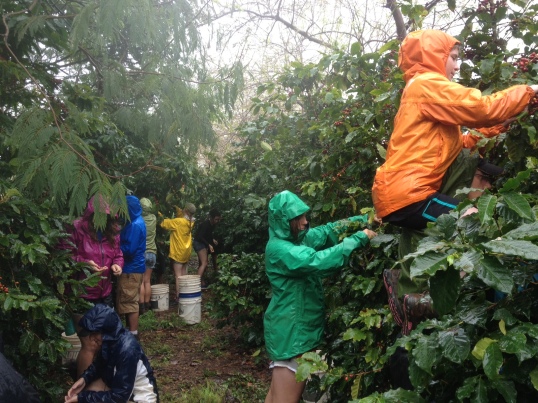
Picking coffee at Kupa`a Farms
Day 3 – Megaptree novergray
We say goodbye to the Maui Seaside for a few nights after a delightful breakfast at the hotel restaurant. We drive to `Iao Valley, which used to be the West Maui caldera. It looks way different than the Kilauea caldera, but a 2 million year age difference can do that to you. The walls of the valley are steep and covered in rainforest. From the parking lot, trails go off in multiple directions, leading to different garden paths and lookout points. After a walk through the beautiful gardens featuring canoe plants brought by the Polynesians, lots of us take pictures in front of the West Maui Needle (Kuka`emoku) in true tourist fashion.
We only spend a little time in here before it’s back in the vans. It’s a short drive to a little lookout point on the southern end of West Maui where we see Kohola galore! We can also see Molokini, Lana`i, and Koho`olawe across the water. These islands, plus Maui and Moloka`i, were all connected when sea levels were significantly lower in the last ice age 20,000 years ago. These shallower waters and island barriers make the place perfect for whales. Most of us who have been slacking on other islands get Megaptera novaeangeliae checked off our species checklists—but some of us aren’t so lucky. Eric makes fun of Sophie by saying, “It’s Megaptree novergray, right?” but he’s not too far off. Sorry, Sophie, maybe another day…
We talk a little about the lava flows that make up the rock we’re sitting on, and we do a little scrambling over the cliff side down the to the water, where we can see the contact point between the younger, alkalic lavas and the older tholeiitic lavas. (See Bennett’s stylin’ pineapple hat for scale).
After we all make some artful sketches, it’s a scramble up the cliff, and then an awesome afternoon at the Maui Ocean Center! We have a great time exploring the aquarium, and many of us came face to face with our spirit animals!
Then before we know it, some of us are trying our hardest not to toss our lunch on the road to Kipahulu. We pitch our tents at the NPS campsite, and check out our surroundings: we can see Hawai’i from here! There are also some pretty cool tide pools, and some of us get closer to them than others (cough, Lopez, cough). The stars are fantastic, but most of us are in bed by 8:30.

Hey He`e!

`Iao Valley

View of Hawaii`i from Kapahulu, Maui

Bennett with alkalic lavas capping tholeiitic basalt
Day 4 – Seven Pools
The next day, we pack up our campsite, and we’re on the road a half hour early—woo! We go a couple hundred yards up the road before we pull into another parking lot and Kumu announces that we’re free to roam the Kipuhulu area. This includes swimming in the pools at Ohe’o, and trekking through the bamboo forest up to the Falls of Makahiku and Waimoku. The trail leading up to the bamboo forest is shaded by kamani haole, which you can tell because 1 in 5 (or 1 in 1 in some cases…) of the leaves are red instead of green. There’s also a bunch of wild coffee growing around—we couldn’t miss it after spending so much time with it at Gerry’s.
The bamboo forest itself is unbelievably cool—most of us have never seen anything like it. The temperature drops what feels like 20 degrees once you enter it. It’s dark, and you almost expect to see pandas prowling behind the green walls of thick stalks. This stuff is so strong, even though it looks flimsy, and many of us feel like it’s such a shame that it’s an invasive. Most of us do the hike to the waterfall, which only flows a little today because it’s been so dry, and then head back down towards the pools for lunch. The pools are so pleasant to swim in, and some of us do some sweet rock jumping after much coaxing and reassurance from the braver souls.
Early afternoon, we assemble in the parking lot. We (barely) survive the road back, and get on our way to the other Haleakala campsite: Hosmer Grove. We arrive surrounded by pine trees, and the wind is blowing clouds directly over our heads. It’s pretty cold, I won’t lie to you, and the wind is insane. Little do we know this is only a taste of what’s to come….

Non-native bamboo

Pools at Ohe`o
Day 5 – House of the Sun: Part I
I’m up at 5:45 and in a van by 6 to watch the sunrise near the summit of Haleakala. The clouds are kind of in the way, but the view of West Maui was unbelievable. I’m not even tired since I went to bed at 8:00… do I get to keep this sleep schedule at Cornell?
After we give up on the sunrise and head back to the campground, I put the finishing touches on my backpack. I pile into Kumu’s van with a few of my fellow compatriots and we’re off to the visitor’s center to get our permit for Kapalaoa Cabin. We’re asked to watch an informative video about leaving no trace in the park, and are reminded once more that whatever we bring in, we must take out. Krysden does a little shopping, Eric admires the Silver Sword hybrids out front, and Emma uses “the real bathroom.”
Within the hour, we’ve all been dropped off at the summit. The wind is blowing like a hurricane and the rain is falling sideways. Remember when Steve said we could wear shorts and a t-shirt? Alice, Kumu, Nick, and Virginia shuffle the cars around, so there’s something waiting for us when we crawl out on the other side. When they get back, we’re off.
Hiking in, I can’t see anything but clouds and the gray sliding rocks beneath my feet. I’m following a ghostly rail of backpacks—and all of them have rain covers, except for mine. Damn it. Occasionally, the clouds to my left blow away and I can see the crater shining in bright, hot sunlight. It really does look like Mars. I’m trying to be interested in the view, but I find that it’s more crucial that I focus on the trail in front of me and trying not to blow my knees out as we descend ~3000 feet.
I have my hood up, hat on, neck gator over my face, but I’m still feeling piercing rain drops hitting what little exposed skin I have. Wind is blowing my pants against my legs in such a way that I have a second, North Face skin. When the wind shifts direction, I’m a human sailboat, thanks to my huge backpack, and I’m almost knocked over a few times.
As we descend, I see more things—silver swords, pukiawes (which I’ve decided will grow literally anywhere), ferns, grasses, and little yellow primroses. It’s the familiar stark lava flow plant life that I’ve come to love. But it’s hard to love it right now—because even though I’ve reached the crater floor, I’m still two miles from Kapalaoa Cabin and now it’s raining in earnest. A trail fork leads left, to Holua Cabin across the crater, where the sun is shining and the Nenes are singing (in comparison).
Eric and I make it to the cabin first, but everyone arrives soon after. Even Kumu says it’s miserable—and that’s when you know. We dry things by the fire, take naps, and make too much ramen that we’ll have to carry out. Before bed, Kumu tells us stories about Maui—Hawaiian Superman—how he found the fire, pushed the sky up, and slowed down the sun. I love Hawaiian folklore.
We go to sleep at 8:30—and I’m up at 10, then 12:15, then 2, then 4. The wind is howling so loud—it’s going to bring the cabin down, I swear.

Maui sunrise

Just a tropical Hawaiian day

Ke`onehe`ehe`e Trail

Ka makani!!!

The view peeks through
Day 6 – House of the Sun: Part II
Somehow, we all survive the night. By 7:30, we’re all awake and oatmealed and packing up our stuff. Someone—maybe?—puts on Sierra’s pants.*
“Can we wait for the wind to die down first?” Sophie asks. Someone replies that we’ll be at Kapalaoa all day if we do that. I agree. I’m eager to get started. It’s 8:15 when we leave Kapalaoa behind.
Trailhead reads: Holua – 4.3 miles. It’s almost flat, but that’s not the hard part. Remember the human sailboat thing? Multiply that by 200. Remember the piercing needles of rain? Throw some sand and bits of rock in there, too. I know because something flies into my mouth and I crunch down on it—headache for the rest of the day.
There’s one part of the trail where I’m walking between two Pu’u and the wind is blowing so hard that I’m leaning forward trying to move, but I can’t. I’m suspended in motion, and I’m wondering how anyone managed to pass this way yesterday. Oh well—at least there’s a rainbow ahead of me right? There are rainbows after rainbows after rainbows—but I’ve decided that all rainbows mean is that the sun is shining, taunting us, while the rain blows sideways into my ears. This is more annoying than no sun at all.
We reach Holua at about 9:15, and all the food I brought for lunch is gone by 9:30. I miss my Fig Newtons, and rue the day I only bought two boxes. The Kapalaoa Krew wastes no time, and soon, Mary, Alli, Sierra, and myself are leading the trek towards the Park Road. Sierra asks, “Wait, these aren’t my pants. Is someone wearing my pants?” for 3.9 miles. A laughable distance, right? …right? Oh, sorry, did I not mention the switchbacks? Remember that ~3000 foot descent I told you about? We have to get back up that somehow, and the way Haleakala has chosen is to present us with two good miles of narrow switchbacks on the wall of the crater.
Next thing I know, I’m leaning against a rock, hanging on for my life. The wind is so bad that I almost can’t breathe. Phoebe isn’t far behind, taking a picture of me struggling to get around this bend. I turn to her and try to yell, “I don’t think I can do this!” but she doesn’t hear me. Thank goodness—because that would have been embarrassing, and it doesn’t even matter, because the next moment, the wind suddenly stops.
I’m standing there thinking, “I can wait here for Phoebe, the next gust of wind, and my demise, or I can run.” So I run, for awhile, actually, until I reach the other side of the cliff face. The rest of the way up is kind of a blur. I remember thinking that moving at this pace up this hill was harder than any half marathon I’ve ever done. I also almost toss up my PB&J and figgy newts—wish I still had those figgy newts.
Eventually, I run into Nick, coming down the trail from the opposite direction. He had gone to Holua Cabin the previous day, and I was confused to see him. I catch myself thinking, “Maybe I’ve died, and he’s some kind of merciful angel here to carry my backpack as far as purgatory…” Then, the more rational side kicked in, and I thought, “PEOPLE! I must be close!”
He tells me I’m about halfway there, and I think a little bit of me died inside. He moves on to check in with the rest of the folks on the trail. The running episode had put me pretty far ahead of everyone else, so now it was just me in front. Lonely, but nice, just me and my breathing.
I see plants, and I wave to people going in the opposite direction. I look like a tomato, but I feel great. Seeing the ocean from this high up is a pleasant reminder of where I am—if it doesn’t end up being the hardest thing I’ve ever done, it’s certainly the coolest. I reach the end of the switchbacks, and the sign tells me it’s 0.7 miles to the parking lot. I’m deliriously putting one foot in front of the other by the time I see the cars—I slow down significantly, but suddenly, there’s Virginia! And Steve, who takes my backpack off and lets me sit in the middle of the parking lot with a box of Maui Caramacs.
The runner’s high is unreal—I’m so glad I did that, and, sorry Emma, but when can we go again?
*Whether or not Sierra was actually wearing her pants has yet to be determined.
– Christina

Rainbows mean “It’s raining.”

Halema`u Trail

Ka makani again, and again…





